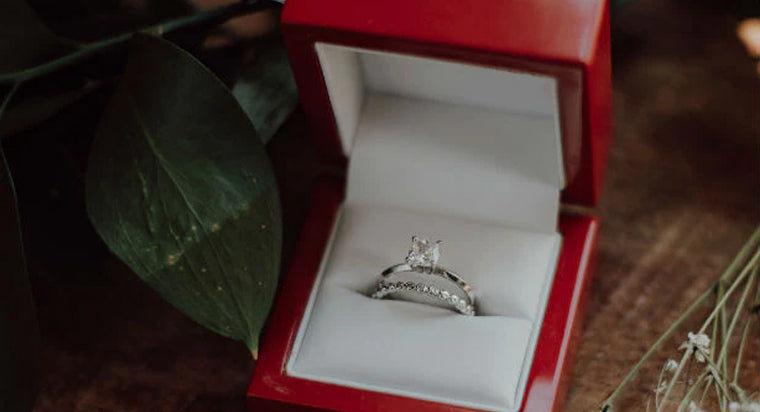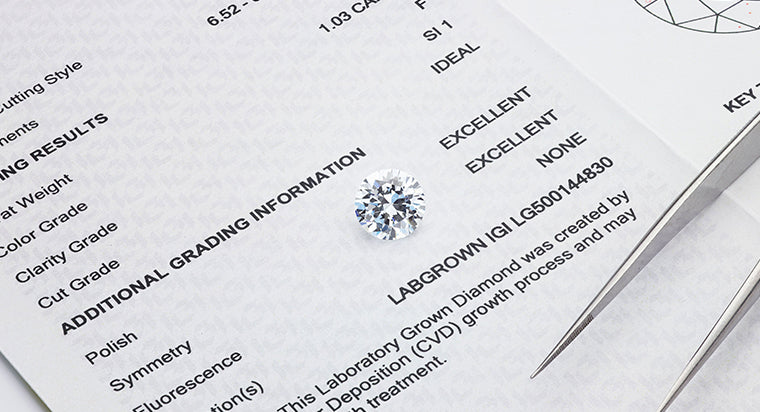What Exactly Is Diamond Fluorescence, And Is It Good Or Bad?

People don't tend to think about diamond fluorescence until later in their research, as a side-line or a chaser, so to speak. But it's worth learning about at the beginning of your loose diamond shopping adventure, because it tends to crop up and cause a bit of anxiety at the last minute.
Why? You could say that fluorescence is the Cardi B of the diamond industry — there is a bit of confusion about what it is, and whether it's good or bad.
TABLE OF CONTENTS
What is Diamond Fluorescence?
Diamond fluorescence is often the most misunderstood attribute of a diamond. Fluorescence is simply the diamond's reaction to UV light, a.k.a. black light. Diamonds with fluorescence will glow or radiate a blue color in a UV environment. (This glow can also be white, yellow, green or even red). Fluorescence can be found in about 30% of all gem-quality diamonds. It comes from the inclusion of trace elements naturally contained within a diamond during the carbon crystallization process.
Is Diamond Fluorescence Good or Bad?
To start answering this question, watch our co-founder Anubh explain:
The Gemological Institute of America has extensively studied the concepts of fluorescence and whether it impacts the visual appearance of a diamond. After years of testing, they found that there is no material effect on the sparkle or visibility. Here's their diamond fluorescence study. Our experience as gemologists tells us that this is mostly true — except in less than 1% of cases where it has an impact, whether positive or negative.
Benefits of Shopping for Lab Diamonds
Affordability
Lab diamonds are generally less expensive than natural diamonds. They can be up to 50% less expensive and equally beautiful. This enables one to purchase a larger or higher quality diamond within the same budget.
Sustainability
The amount of energy that it takes to grow a diamond in a lab is less than the amount of energy required to dig a diamond out of the ground. There is less transportation, labor, and impact on the earth. Lab-grown diamonds are the more environmentally-friendly choice.
Availability
Lab Diamonds are created in a controlled lab environment in a variety of shapes, colors, and qualities. This ensures that you can get a diamond that is exactly what you want, within the budget that you have set for yourself.
When is Diamond Fluorescence Bad?
Remember that diamond color is graded on a scale from D (colorless) to Z (light color). Fluorescence can have a negative effect on higher colored stones, such as those graded D, E and F.
At times, diamonds with very strong blue fluorescence can reveal an oily, milky, hazy or grayish look, dulling or darkening the diamond. For this reason, With Clarity doesn’t carry very strong blue diamonds. You typically don’t need to worry about this in the other grades, which are “none”, “faint” and “medium”. For Strong Blue diamonds, simply contact a With Clarity gemologist. We'll tell you more about the particular stone.

When is Diamond Fluorescence Good?
In diamond colors with a warm yellow tint, such as those graded J through L, strong or medium fluorescence can make the diamond appear whiter and remove some of that faint yellow hue. Keep in mind the difference is very minor — it will not make a J color diamond look like a D, E or F color. (When a diamond is one of those higher-graded colors, the extra whitening effect can adversely affect the diamond — again, in a very small number of cases.) But it can help J color diamonds look like I color diamonds, a difference of one color grade, in many cases.

Most of the time, though, fluorescence is neutral. It doesn't affect sparkle, structural integrity, or strength. It's essentially a diamond side effect, but nothing more.
How Diamond Fluorescence Impacts Cost
Fluorescent diamonds generally cost 10% to 15% less than diamonds graded “faint” or “none.” That means great value and major savings. Remember: Fluorescence very rarely affects a diamond in any visual way. GIA simply measures it for transparency purposes.
Want to speak straight to one of our expert gemologists about diamond fluorescence or a stone that caught your eye on our website? We'd love to chat. Reach out now.







